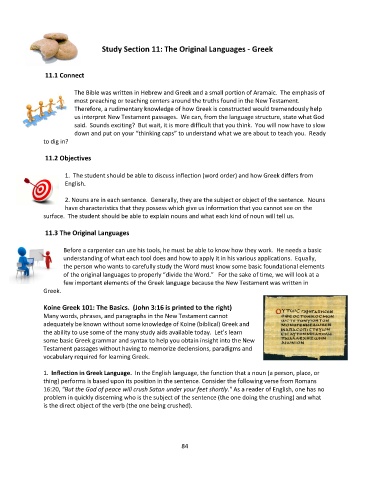Page 85 - Doctrine and History of the Preservation of the Bible Student Textbook
P. 85
Study Section 11: The Original Languages - Greek
11.1 Connect
The Bible was written in Hebrew and Greek and a small portion of Aramaic. The emphasis of
most preaching or teaching centers around the truths found in the New Testament.
Therefore, a rudimentary knowledge of how Greek is constructed would tremendously help
us interpret New Testament passages. We can, from the language structure, state what God
said. Sounds exciting? But wait, it is more difficult that you think. You will now have to slow
down and put on your “thinking caps” to understand what we are about to teach you. Ready
to dig in?
11.2 Objectives
1. The student should be able to discuss inflection (word order) and how Greek differs from
English.
2. Nouns are in each sentence. Generally, they are the subject or object of the sentence. Nouns
have characteristics that they possess which give us information that you cannot see on the
surface. The student should be able to explain nouns and what each kind of noun will tell us.
11.3 The Original Languages
Before a carpenter can use his tools, he must be able to know how they work. He needs a basic
understanding of what each tool does and how to apply it in his various applications. Equally,
the person who wants to carefully study the Word must know some basic foundational elements
of the original languages to properly “divide the Word.” For the sake of time, we will look at a
few important elements of the Greek language because the New Testament was written in
Greek.
Koine Greek 101: The Basics. (John 3:16 is printed to the right)
Many words, phrases, and paragraphs in the New Testament cannot
adequately be known without some knowledge of Koine (biblical) Greek and
the ability to use some of the many study aids available today. Let’s learn
some basic Greek grammar and syntax to help you obtain insight into the New
Testament passages without having to memorize declensions, paradigms and
vocabulary required for learning Greek.
1. Inflection in Greek Language. In the English language, the function that a noun (a person, place, or
thing) performs is based upon its position in the sentence. Consider the following verse from Romans
16:20, "But the God of peace will crush Satan under your feet shortly." As a reader of English, one has no
problem in quickly discerning who is the subject of the sentence (the one doing the crushing) and what
is the direct object of the verb (the one being crushed).
84

